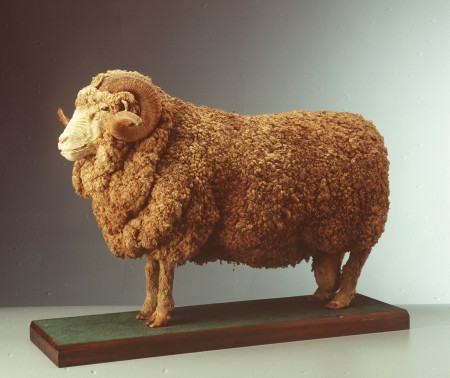
When you think about the Industrial Revolution steam engines, factory manufacturing and railways all spring to mind. What about the wool industry in Australia? How could sheep grazing on vast tracts of land here and the production of wool be influenced by the Industrial Revolution in Britain? A surprising amount it would appear.
Early days
The famous pastoralists,
John and
Elizabeth Macarthur,
established a colonial wool industry in Australia in the early decades of the 1800s with rare
Spanish sheep. Compared to growing crops, sheep could be grazed with little labour. It was the
ideal agricultural product that fledgling Australian colonies could export back to England by
ship without it perishing. The big challenge was actually selling it in England.
The production of wool in Australia was disadvantaged from the start. Transport costs were high as it was half way around the world from markets and there was no infrastructure in place to bring it from the outback stations to waiting ships. The Australian climate and landscape, so much dirtier and dustier than Europe, made our wool grubby and more difficult to sell. Our droughts made water supply erratic and diseases were prevalent. Yet during the first half of the 1800s an amazing thing happened. In 1815 Britain was getting most of its wool for its textile mills from Spain (over 3,000 tons) and Germany (1,400 tons) annually with Australia only supplying 33 tons of wool. By 1849, this had completely turned around. The Australian colonies became the dominant suppliers, selling England a staggering 16,300 tons of wool that year. This was more than all of Europe’s production combined. Throughout most of the 1800s, wool was our most important export increasing many times over.
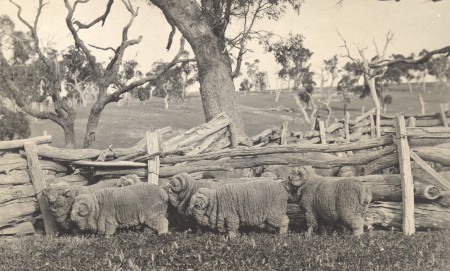
Breeding and fencing
Australia’s early graziers drew on the global stock of genetic and mechanical know-how. They
came from Britain, the world’s most advanced economy, and used the vast accumulated knowledge
driving the Industrial Revolution there. Australia was a late participant in the Industrial
Revolution but benefitted from decades of earlier technological development.
At first Australian shepherds tended the colonial flocks but the gold rushes lured them away and fences were erected to keep the sheep from straying. Fences encouraged selective breeding, disease control and improved the quality and quantity of wool and kept dingos at bay. Initially, crude piles of Mulga wood were used to enclose paddocks but these were later replaced by wire fences. Initially imported from Britain, fencing wire and netting was locally made from 1880. Wire fences needed to be kept tight to be effective and wire strainers were developed and manufactured in Australia and New Zealand.
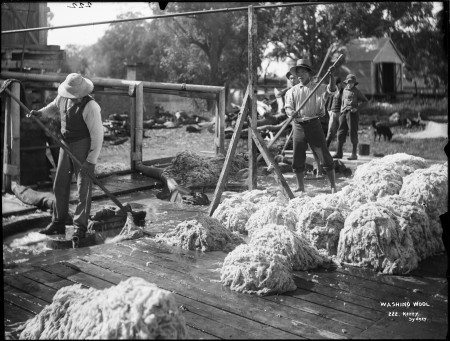
Washing wool
Washing sheep before shearing was central to the marketability of wool in England. It reduced
transport costs by removing some of the grease, dirt, grass seeds, twigs and burrs so that the
fleece. This meant that Australian wool could compete with the European producers. In the early
days sheep were run into streams, washed in tubs of soapy water, and rinsed off. Later, special
water runs were built and dams erected for wool washing. The introduction of steam engines to
heat the water washed the wool even better. Larger establishments like
wool scouring works, also powered by steam, were erected to
remove the grease and clean the wool.
Managing water
Ensuring a good reliable water supply was essential to extending sheep grazing lands. Tanks or
dams were built to store water. These were dug out with large scoops hauled by
teams of horses or bullocks. As sheep can only walk about 6 km
from pasture to water each day, windmills pumped up
underground water to drinking troughs or tanks for them. These were initially made in the USA
but later manufactured extensively in Australia becoming ubiquitous to the landscape. From the
1880s artesian water, vast underground mineralised water supplies, further opened up enormous
tracts of new land for sheep.
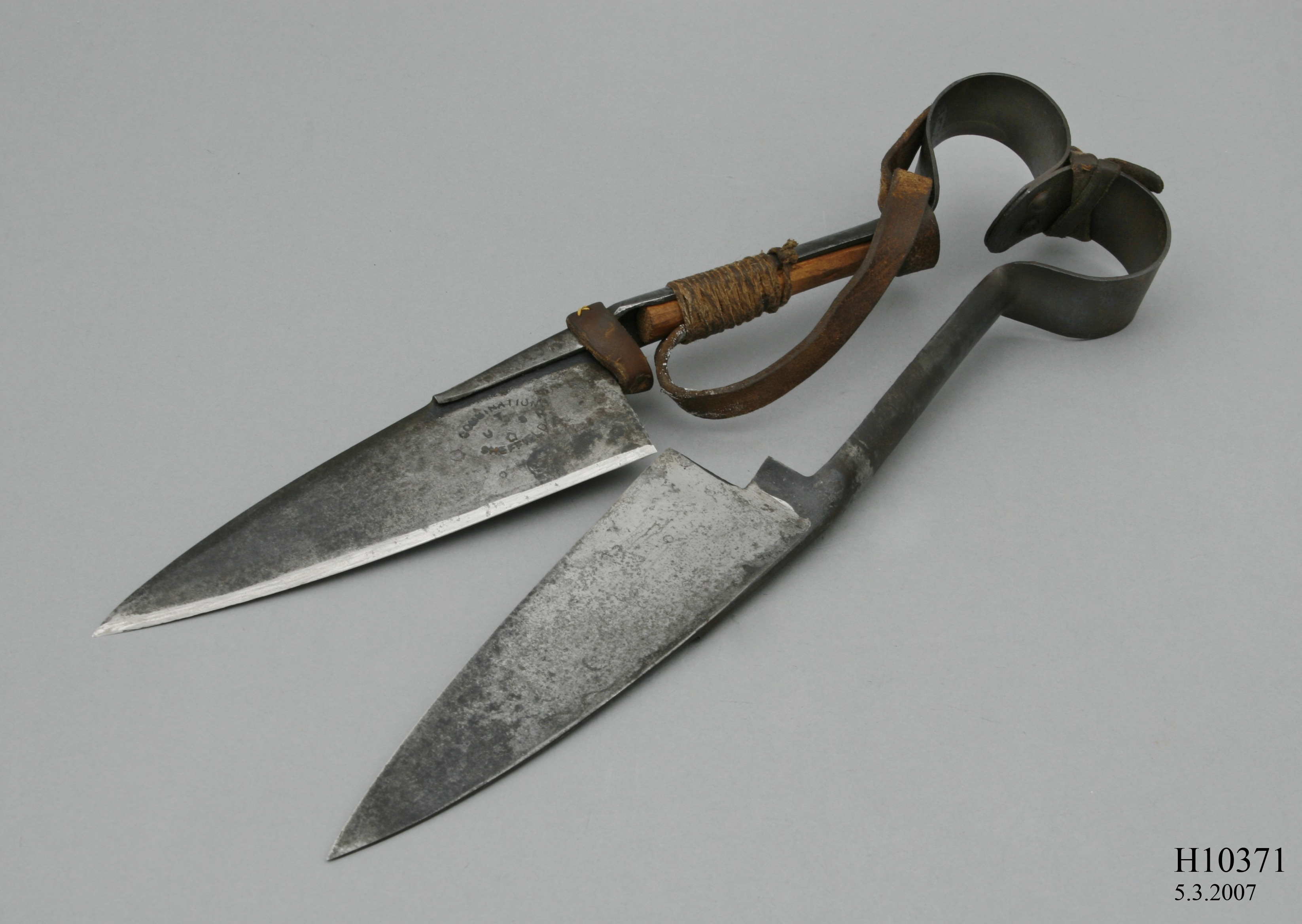
Shearing the sheep
Australia provided a large market for hand shears made at the
English edge steel works around Sheffield. English manufacturers even travelled to Australia to
research the needs of Australian shearers. By the late 1800s numerous Australian patents
eventuated in the development of
sheep shearing machines which shore sheep faster, removed
more fleece and required less skill than hand shearing.
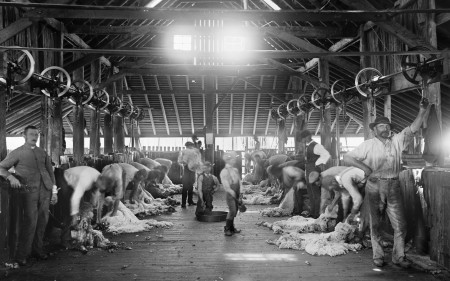
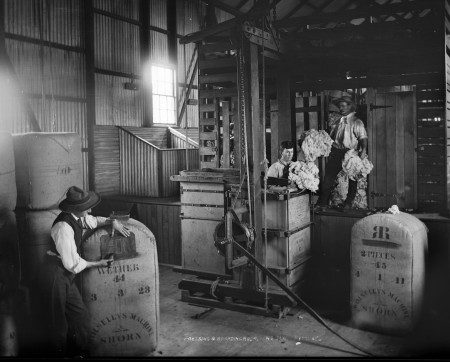
Pressing the wool
To make wool cheaper and easier to transport it was compressed into bales by wool presses in the
shearing shed. Again Australian and overseas inventors and manufacturers worked to develop and
refine wool presses during the 1800s. One of the most popular
was the Koerstz, made in Sydney.
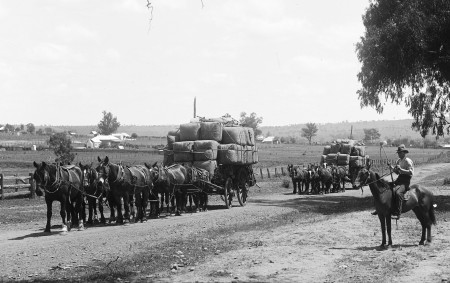
Transport
Most people assume that the
first railways in New South Wales were to transport people but the driving force for their construction was pressure from
Goulburn graziers. They wanted a cheaper method of transporting their wool rather than the
slow bullock drays and wagons travelling overland. Railways
not only transported wool to the coast for transport to England by
fast clipper ships but brought back the latest shearing
machines and steam and oil engines to run them. As well as goods they transported knowledge
through publications such as books, newspapers and journals containing the latest information
for graziers about breeding, combating disease and water conservation.
The Australian wool industry developed because of the Industrial Revolution. It spawned local factories to make equipment for Australian conditions from sheep shearing equipment to fencing supplies and from sheep dips for disease control to wagons for transporting the wool to the rail head. Steam engines powered the shearing machines and heated the water for wool washing and scouring. Rail transport made wool production competitive while the visual success of this industry was reflected in the enormous wool stores erected all over cities like Sydney for its storage.
Post by Margaret Simpson, Curator
References
Raby, Geoff, ‘Making Rural Australia: an economic history of technical and institutional
creativity 1788-1860’, Oxford University Press, Melbourne, 1996, pp. 94-111
Margaret, thank you for this terrific blog post. It combines two of my fascinations – the Australian wool industry and the Industrial Revolution, and I thoroughly enjoyed reading it – twice. Great photos, too.
Thanks for your comments Penny. I’ll pass them onto Margaret.
Tilly, Blog editor
It was so intersesting to read , thank you very much.
I am a Hungarian wool trader, and I think we also need to make a similar revolution nowadays in Hungary as well.
Its incredible to see Ferrier press as vintage, becouse I still use it in my station called Estancia Penitente in Patagonia Chile.
Thank you for posting this it is really helping with my history assignment that I have to do for school. It is on the industrial revolution and how it impacted Australia ??
Omg!! Same. This article did really help thx. Good luck with ur score too!!
Your right this really did help, I’ve been looking for information on the wool industry in Australia for an important history assignment. I was having a lot of trouble trying to find websites to get information from, I hope you two get good marks, good luck.
thank you so much! the wool industry is my passion, so riveting!!!
Great article. I was disappointed that no mention was made of Eliza Forlong and her contribution to the wool industry, especially as the Taylor family bought the Forlongs property of Kenilworth in Tasmania and the sheep flock of cross bred marinos and Saxon sheep.
Is it true the Macarthur flock kept with the full bred spanish marinos?
There are several monuments recognising Eliza’s contribution to the wool industry.
I am doing some personal research hope you can enlighten me
Patricia Kirkman
Townsville 4810
Hi Patricia,
Thanks for getting in touch. I spoke with Curator Margaret Simpson, who said that, unfortunately, to cover so much content in so few words we were unable to include all the developments of the wool industry, such as Eliza’s contribution, and that we don’t have any further information we can share with you on this topic. Best of luck with your research!
Kind regards,
Sarah Reeves, MAAS
This helped so much with school work. Thx so much